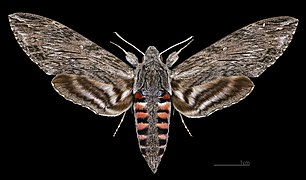Agrius convolvuli
| Agrius convolvuli | |
|---|---|

| |

| |
| Scientific classification | |
| Domain: | Eukaryota |
| Kingdom: | Animalia |
| Phylum: | Arthropoda |
| Class: | Insecta |
| Order: | Lepidoptera |
| Family: | Sphingidae |
| Genus: | Agrius |
| Species: | A. convolvuli
|
| Binomial name | |
| Agrius convolvuli | |

| |
| Distribution (red – permanent; orange – migrant) | |
| Synonyms | |
| |
Agrius convolvuli, the convolvulus hawk-moth, is a large hawk-moth. It is common throughout Europe, Asia, Africa,[3] Australia[4] and New Zealand,[5] partly as a migrant. In New Zealand, it is also known as the kumara moth, and in the Māori language as hīhue.[6]
Description and habits
[edit]The wingspan is 80–105 mm. This hawkmoth's basic coloration is in grayish tones, but the abdomen has a broad gray dorsal stripe and pink and black bands edged with white on the sides. The hindwings are light gray with darker broad crosslines.[7]
-
♂
-
♂ △
-
♀
-
♀ △
Its favourite time is around sunset and during the twilight, when it is seen in gardens hovering over the flowers. This moth is very attracted to light, so it is often killed by cars on highways. Its caterpillars eat the leaves of the Convolvulus, hence its Latin name "convolvuli". Other recorded food plants include a wide range of plants in the families Araceae, Convolvulaceae, Leguminosae and Malvaceae. It can be a pest of cultivated Ipomoea batatas (sweet potato or kūmara) in New Zealand and the Pacific. It feeds on the wing and has a very long proboscis (longer than its body) that enables it to feed on long trumpet-like flowers such as Nicotiana sylvestris.[8]
The caterpillars can be in a number of different colours. As well as brown (pictured below) they have been seen in bright green and black.[9]
Similar species
[edit]A. convolvuli is unmistakable in the eastern area of distribution, in the western area of distribution it can be mistaken for Agrius cingulata. This species, found mainly in South and Central America, is repeatedly detected on the western shores of Europe. Agrius cingulata can be distinguished on the basis of the clearly stronger pink colouring of the abdominal segments and a similarly coloured rear wing base. In addition, Agrius convolvuli form pseudoconvolvuli Schaufuss, 1870 has some resemblance with North American species in the genus Manduca, for instance Manduca sexta.[citation needed]
Gallery
[edit]-
Agrius convoluli variation
-
Larva of Agrius convolvuli
-
Larva of Agrius convolvuli
-
Pupa of Agrius convolvuli
-
Feeding in flight
References
[edit]- ^ "CATE Creating a Taxonomic eScience - Sphingidae". Cate-sphingidae.org. Archived from the original on 2012-11-13. Retrieved 2011-11-01.
- ^ Pittaway, A. R.; Kitching, I. J. "Agrius convolvuli (Linnaeus, 1758) -- Convolvulus hawkmoth". Sphingidae of the Eastern Palaearctic. Retrieved December 13, 2018.
- ^ Butler, Arthur Gardiner (1879). "Lepidoptera". Philosophical Transactions of the Royal Society of London. 168: 541–544. JSTOR 109269.
- ^ "Ozanimals". Ozanimals. Retrieved 2011-11-01.
- ^ "Agrius convolvuli (Linnaeus, 1758)". www.nzor.org.nz. Landcare Research New Zealand Ltd. Retrieved 16 July 2017.
- ^ www.vo2.co.nz. "hīhue - Māori Dictionary". maoridictionary.co.nz. Retrieved 2018-02-14.
{{cite web}}: CS1 maint: numeric names: authors list (link) - ^ Hampson, G. F. (1892). The Fauna of British India, Including Ceylon and Burma: Moths Volume I. Taylor and Francis – via Biodiversity Heritage Library.
- ^ Michael Chinery, Collins Guide to the Insects of Great Britain and Western Europe
- ^ Pittaway, A. R.; Kitching, I. J. "Agrius convolvuli (Linnaeus, 1758) -- Convolvulus hawkmoth". Sphingidae of the Eastern Palaearctic. Retrieved December 13, 2018.
External links
[edit] Media related to Agrius convolvuli at Wikimedia Commons
Media related to Agrius convolvuli at Wikimedia Commons- Convolvulus Hawk-moth at UKMoths
- Description in Richard South The Moths of the British Isles
- Lepiforum e.V.










